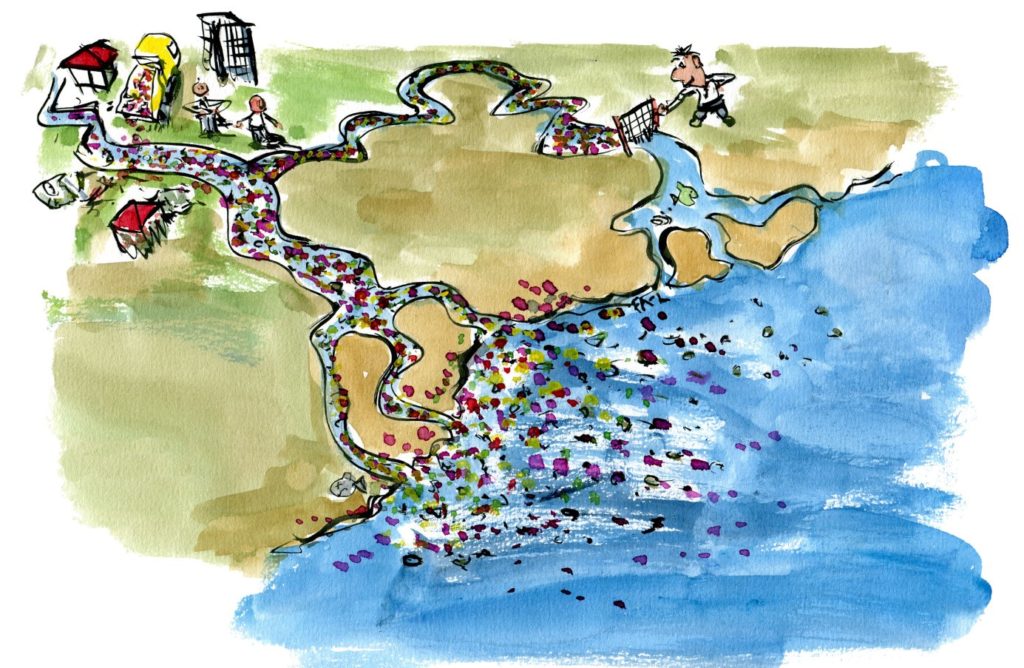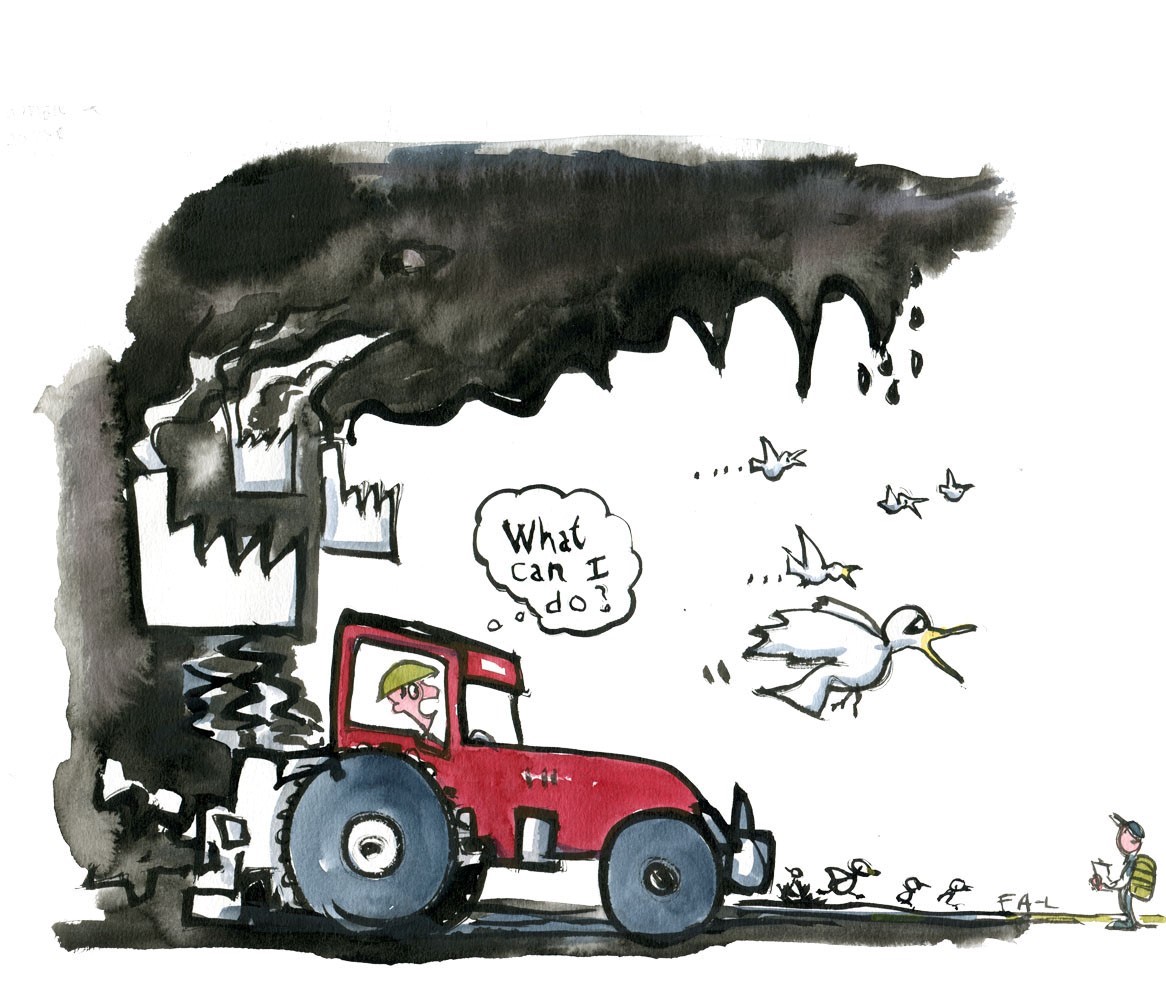Illustration by Frits Ahlefeldt
November 2020
Illustrations by Frits Ahlefeldt
The Reality on Ground
A road trip to Vrindavan is a reality check on water. An Ashram – a social network for the elderly is in need of an economical water solution. We stop at a prosperous-looking farm on the banks of the river Yamuna. A crop of mustard is being sowed. The owner comes with an earthy grin and offers us hot tea. We chat and learn that the electricity is erratic, so he leaves his pumps on for irrigation and floods the farm. We talk about productivity, water, irrigation, and fertilizer. He is oblivious to most of it, including drip irrigation. After all, water is ample and electricity-free so why bother about such things? We have practiced this for generations. Is the government paying to use it? A further small talk over a hot kachori reveals that the water table has been falling, pump failures are frequent, the water smells bad but seems to be working well for the crop. What the farmer is pumping is the discharged sewage water from upstream which has contaminated the groundwater. It reminds me of a cousin saying, “The rivers of India are at direct communication with the lower end of the gastrointestinal tract of those who live upstream and with the upper end of those who live downstream.” For me, the trip yields no business. I am ridiculed by the water budget and treatment scheme. The learned managing committee of retired professionals resonates, if the water is free the treatment scheme should be free too! The tell-tale signs of climate change and resource exploitation are evident at Vrindavan. The water table is falling, the farm does not yield as much as it used to, the summers are hotter as evident from a few wilting trees and Yamuna has lost its vigour throughout the year.
We drive through the winding roads of Pauri, Uttarakhand on behest of a concerned minister. We stop at a dozen water treatment plants on banks of rivers. Sample water, and test it. The results are the same – excellent physical and chemical properties but all test positive for E.coli – an indicative bacterium for fecal contamination. The villages we traverse have open gutters filled with plastic or none at all. The sewage finds its way into clean water. The ray of hope is the pine trees being replaced by the local bhaanj which retains water in its deep taproots and provides potable water round the year. A lesson in sustainability. Humans have gone back to their routes, rejecting the ‘modern’ ways of managing forests and water.

Families in the villages have to walk fifty to a hundred meters to fetch water for daily use. The sanitation facilities are common and kept clean. The water from the common toilets is let out without treatment. The thriving shrubs downstream of the discharge are a testament to the presence of nutrient-rich untreated sewage.
Towards the end of the journey, we stop at the local kirana store to buy a bottle of water. It is closed. A neighbor proudly offers us ‘pure’ water from his proud new possession, a RO water purifier, a sign of new-found prosperity from selling land. We drink, almost distilled water without bacteria, and head towards Rishikesh.
Again, the telltale signs of climate change are evident. Reducing tree cover, heavy erosion due to bursts and floods. The aging treatment plants run with inefficient motors installed through an L1 capital cost proposal, consuming far more power and thus contributing to carbon emissions.
We shift gears to the affluence of Mumbai. Alibaug – the Hamptons of Bombay, is a quiet hamlet 14 km south of Mumbai as the crow flies. The million-plus dollar weekend homes have a perennial problem of seeking the elixir of life, either from the wells on their property or from tankers which roam the pot-holed roads as the messiahs for the lush green lawns and swimming pools. There is no piped water in Alibaug! Sewage and waste management do not even get an honorable mention and rainwater harvesting is a great topic for WhatsApp University! After all, there is no payback for rainwater harvesting and storage compared to the cost of a tanker! The locals have their hand pumps and the gram panchayats provide a ¾” line for 1 hour of water. The irony is that the area receives one of the highest rainfalls, almost 2400 mm per year. I visit a friend’s house for a pro bono consultation about his water woes. The three borewells he has, play musical chair every monsoon – who will be the saline one that season? The salinity level changes every year thanks to the intruding seawater. Again, a telltale sign of impounding effects of rising sea levels due to climate change rushing into the voids created by over-extraction of groundwater.
Water in India

India receives 4000 km3 of precipitation every year through a fairly predictable monsoon. The majority of it occurs in four months from June through September. The intensity and the patterns vary because of the geography and regional climates. Half of the precipitation runs off to the sea, balance is used to charge the surface and groundwater. The agriculture sector is the largest consumer of water at 83%, followed by the power and industrial sector at 6% each and potable use at about 5%. The quantum of water we receive will remain more or less persistent but the demand will grow on all fronts.
Access to water is a quagmire. The agriculture water is virtually free, potable water is charged but does not cover the cost of operations. The industries are charged for water. It partially subsidies other uses. As a consequence, the crop patterns are skewed, productivity with respect to water is dismal, and depletion of groundwater is alarming.
Access to potable water is even more disturbing. In rural areas, 12% of households have access to piped water. In urban areas, this number is 40%.
The sewage situation in India is dismal. We generate 78 billion liters of sewage a day out of which 23 billion liters are treated. The balance goes to our water bodies with partial or no treatment.
Storylines of water running across India are similar only the plots twist and turn: Water is available, access is not. Sources are drying up. Floods are galore. Droughts are rampant. Quality is dubious. Salinity is increasing. Water treatment does not work. Water is not priced but de facto privatized through tanker lobbies. Agriculture receives virtually free water. We buy some of the most expensive water in bottles. The majority of the polity is oblivious to the nuances and complexity of water.
The heavy burden of the past water woes, tattered and inadequate water infrastructure, the present reality of climate change and global warming have accentuated the water situation. It needs to be tended now with a heightened urgency to prevent an apocalypse. We have very little room to maneuver the situation in time before we are squeezed against a rock and a hard place.

Climate Change and Water
Climate change is a reality, not a point of debate. In a short span of the last 300 years, the earth has seen a million new chemical entities, greenhouse gas emissions, more fossil fuel burnt than any time in its life, concrete jungles, and forest land cleared for agriculture and urbanization. It is an equivalent of a Dirac Delta function of the earth’s environment. The decay of this function over time has manifested as global warming as the major outcome. The implications are dire: Increased transpiration and water needs for vegetation and humans, expansion of sea levels leading to salinity intrusion, dwindling freshwater resources, local hot spots, extinction of habitats and biodiversity, and increased freshwater demand. Extreme weather events leading to storms, floods, droughts, erosion, seawater ingress, and destruction of property and life are a daily affair. All these affect the availability of fresh water for human use. Economically, more than 39% of Indian Banks’ portfolio is exposed to sectors that face high levels of operational risk related to water and climate change. Worldwide, flood risk due to rising sea levels and cloud bursts are the major risk factors for real estate.
A Relook at Water
A nation of 1.3 billion people has to be fed and its thirst quenched. Economic growth which improves health and the standard of living needs to be addressed urgently. The water resources, some of which are shared with other countries have to be addressed for long-term water security.
Ownership and Governance
A 100-year water vision is a necessity, not an also-ran agenda. Civilizations have died and thrived because of water. The vision needs to recognize that water is a basic necessity, not a political tool to manipulate the republic for winning elections.

Whom does the water belong to? This debate is indispensable for water sustainability. A clear answer is a must for governance. A central regulatory agency with geographical sub-divisions may be a good idea with appropriate structures and human resources. Lucid and executable policy and laws are a necessity for sustainable water. Data, water mapping, and on-line water analytics should be used to govern water resources and usage. Water needs to be regulated not politicized. How we bring about these changes is a Herculean task.
Investing in Sustainable Infrastructure
The current realization of using natural systems for the storage of water and mitigating effects of climate change are well recognized. Investments should be made in natural systems for water sustainability and mitigating the effects of climate change. A number of cases are quite promising. An oak forest over 10 km2 serves as a nice example of a watershed to provide potable water to the town Shimla. Rather than damning the rivers through dams, an ecological flow should be ensured in the river systems of India for groundwater recharge, development of wetlands to mitigate floods and provide habitats for biodiversity. Rivers are like a rubber band. They flex themselves to find their way when fertile silt is deposited. Constricting them is a definite way to increase floods and destroy biodiversity. Could we have reimagined Narmada and Tehri projects to be far more sustainable? Can’t the immense solar potential of Kutch be unleashed to develop revolutionary solar desalination technology and create a pioneering industry? It could have alleviated the need to submerge vast forest cover and displace more than a million people from their lands.

Groundwater should be considered as a water bank rather than a water source. The extremities of climate change will then allow us to draw the water reserves in drought and replenish it in good years. For a successful ground resource strategy, mapping of aquifers and development of recharge methods and structures are essential along with withdrawing and groundwater management strategies. It has to be a key part of the 100-year vision and a major element for sustainable water.

Human Behavior and Resources
Besides economics, education is the second lever for behavior change. Sustainability as a part of the high school curriculum will bring this change and create young minds who would be interested in working with water. They can be the change agents. This approach can lay a strong foundation for developing the water champions who address all aspects of water.
Behavior change has to go through a continuous path for it to be imbibed. Making small but continuous changes that do not drastically disrupt the lives of people is essential for a successful behavior change.
Pricing Water
Today, water is virtually free. It discourages any discretion in use. It needs to be priced for behavior change and economic growth. A number of issues need to be addressed before a well thought out pricing strategy can be introduced. An equitable and affordable basic need has to be met. Water needs to be metered. An infrastructure to deliver has to be created. A block tariff model may be used to address equitable distribution as it has been done successfully in Durban. Priced water assures a number of advantages: The consumer can demand quality, quantity and uninterrupted supply, it allows for upkeep and modernization of water supply and importantly forces a behavior to use it responsibly. It allows for improved public health. The reliable and confirmed water supply reduces a large risk factor for farmers. It will help them earn a better living through multiple and high margin crops. Water pricing can make agricultural produce more market-driven.
Pricing of water allows for revenue generation and thus a market to raise funds for water infrastructure projects.
Sewage a Priced Resource
Sewage treatment warrants an incredibly urgent attention because a dismal 30% of it is treated across the country. The two major implications of untreated sewage entering the environment are contamination of clean water sources and public health hazard. Sewage is rich in nutrients for agriculture. It can be treated well with Phytoremediation Technologies for agriculture use or with hybrid technology for non-potable reuse such as cooling tower make up. Enablers for realizing value out of sewage are metering, robust and well managed infrastructure and compliance with the standards. These will allow for multiple use of water before discharge, protection of clean water sources and improved public health.
Role of Technology
Technology will play an increasing role in water sustainability. Agriculture consumes the largest quantum of water today. Today, the penetration of micro-irrigation techniques is less than 3% for all irrigatable land. A yearly target of bringing 2-3 % of land under micro-irrigation will preserve water resources and improve agricultural productivity on all counts. The key to adaptation is creating conducive market conditions through metering, pricing and enabling free markets for agricultural free produce.
The price of decentralized solutions for water treatment is reducing. A cost-benefit analysis of large pipe networks versus decentralized water solutions needs to be addressed. The decentralized solutions reduce large capital outlays, allow for technology customization for water quality and upgradation.
India requires special technologies to address natural contaminants like arsenic, fluoride and iron. We have to deal with them as they are a part of our geology. The increasing affluence will lead to the ingress of pesticides, drugs and excessive fertilizer in water sources. Advanced techniques for water treatment like ozonation will be needed in the future. We need to develop multiple approaches to address contaminant issues.
Reverse Osmosis (RO) is an enigma for India. RO is an expensive technology. To successfully run it, trained manpower, energy, and significant maintenance are required. The environmental footprint of RO is poor. It is power-hungry, generates substantial saline waste and the de-scalants are discharged into the environment as waste.
Using reverse osmosis (RO) or desalination for salinity control, especially for industrial wastewater is necessary. Re-engineering waste-water generation is the need of the hour. As far as possible RO is to be avoided for potable water treatment. Can’t we think of rainwater recharge to reduce salinity for land locked regions? Or use solar energy for desalination using electrodialysis? Adaption of RO needs critical, integrated and holistic thinking before investment. It is an easy way out but a steep price to pay in the long run.
The paradox of sustainable water is a colossal epic. Securing water today will reflect the empathy, courage, imagination and innovations which have gone in providing a sustainable future for the coming generations. It is towards the future of sustainable and abundant water that we should endeavor.
Illustrations by Frits Ahlefeldt
Republished from here.
Around 12–15 entrepreneurs, driven by entrepreneurial energy and passion for a vision, and a little bit of luck, could change the climate crisis into societal transformation.
A dozen or so key technologies/entrepreneurs will make a substantial difference, far more than the next hundred efforts. Entrepreneurs will solve these key markets and technologies leading the industries in these areas to a new transition state. They will be the “instigators” that cause others in each industry to follow their lead. Whether these early entrepreneurs, driven by the power of ideas driven by entrepreneurial energy, are successful or they fail, they will affect change by changing conventional wisdom and making the seemingly impossible possible in each of these segments critical to climate and sustainability. Traditional players may come in to scale these approaches. If we are to affect change by 2040 through the mass adoption of these technologies, they will need to be somewhat “proven” by 2025. That is the set of technologies I am immediately concerned with.
Let me demonstrate with a few stories:
- In 2010 few in the automotive sector took EVs seriously in their planning for the next decade or two. The US Department of Energy forecast almost no fully electric cars by 2035, based on consultation with automotive experts! But this startup with little automotive experience or credibility, Tesla, packaged enough existing technology into a consumer experience that caught the consumer’s imagination and made the whole industry pay attention. A few years later, as their market capitalization climbed and Tesla violated expectations of “not doing it properly per automotive standards” and “going bankrupt”, every major automaker has changed their goals. The change to electric automobiles feels inevitable now as Tesla becomes the most valuable automaker in the world, just a few years past expectations of bankruptcy. The “instigation” worked and is now independent of the fate of the instigator. One person like Elon Musk can change the technology direction, even if it requires no major technology breakthrough. It was a lot of very good engineering, out of the “experts” box thinking and vision for the future.
- In 2011, a lone academic, Pat Brown, another instigator, decided to try and eliminate all animal husbandry given its use of 30–50% of the planet’s land area and its horrendous greenhouse gas (GHG) and water footprint. Many laughed at the idea that a plant protein, even with a roughly 90% lower GHG and water footprint, could be as tasty to non-vegetarians as beef. Today, less than a decade later this is widely accepted and proven in taste tests, and beef may be slowly on its way out starting with the environmentally-conscious millennial generation because they don’t have to give up any “taste” to be so conscientious. Beef, and animal products in general, are large GHG emitters and will slowly be replaced by products like Impossible Foods. Niche technologies exist to reduce its emission (like grass-fed beef or regenerative agriculture) but they are unlikely to scale globally, cost-effectively, to meet rapidly growing demand as the developing world develops. But the world’s view of plant proteins to replace animal proteins is changing rapidly. It helps because most of the IPCC scenarios for carbon reduction require us to free up land area with new carbon-absorbing planting and plant proteins take substantially less land per pound of product.
- Lithium-ion batteries for EV’s have been improving at very slow rates. Jagdeep Singh, an EIR at Khosla Ventures, teamed up with a research team at Stanford University to start Quantumscape, a ten-year effort to develop a solid-state battery with a 100% jump in performance at a dramatically lower cost, instead of the myriad of component technologies and incremental performance improvements being attempted by others. This bold attempt at doubling the end-product performance, extending battery lifetime, enhanced safety, and making fast charging at “gas stations” routine, is more of what is needed. It could dramatically accelerate and make cost-effective the trend towards EVs that Tesla started. The field is rich with efforts but it takes a concentrated push by entrepreneurs like Jagdeep Singh to change the world’s trajectory in EVs. I’d guess it is the only 2x better performance battery likely to be in real cars in volume in the next five years. And it is likely sufficient to make EV’s economic enough to accelerate their adoption and the one-two punch for the gas engine. I suspect, beyond Quantumscape, all major battery makers will have to adopt such a bold direction if they are to survive, creating a herd effect towards 2x universal performance.
- Electric cars and electric trucks powered by renewable electricity are likely solutions, but air transportation by passenger jets needs a liquid fuel compatible with today’s jet fleet if the change is to happen in the next 15–30 years. LanzaJet (a subsidiary of Lanzatech), started in New Zealand a decade ago and partnered by Sean Simpson and Jennifer Holmgren, is building its first pilot plant to produce 100% renewable jet biofuel using gas fermentation technology. The technology is likely to be cost-competitive at scale with today’s jet fuel prices, especially with a little bit of starting help (given the variability of oil prices) as they scale just as solar and wind did before becoming competitive unsubsidized. Though these subsidies for solar and wind still exist, they should not as they are not needed today. There are other jet fuel efforts but it is hard to tell if they will scale and be cost-competitive with LanzaJet. To the best of my knowledge, few are fully operational beyond pilot plants by 2025 or have the scalability of feedstock (old cooking oils don’t scale for example) to achieve global replacement of fossil jet fuel. But we need only one technology to transform air travel, though more competition will help accelerate it.

So what does it take to make a material difference in carbon emissions? A hundred or thousand of these technology/entrepreneur combinations? Surprisingly, even though the GHG problem is hard, a dozen such efforts could accelerate society’s transformation, especially if we think critically about the “right dozen”. Here is my list of these dozen innovation/innovator combinations that we will need to make a large dent in a substantial portion of the emissions in each segment (plenty of niche solutions exist which though good, won’t when scaled and if scaled, will make a material difference): (1) Electric vehicles & Automotive batteries (2) Food & Agriculture, especially meat (3) Low carbon Transportation: Air transportation (jet fuel), shipping (electrofuels, biofuels?) (4) Cement or substitute construction material (5) Low carbon dispatchable electricity generation (fusion, geothermal, nuclear) (6) Public transit (7) Grid storage (long duration battery storage) (8) HVAC (9) Industrial processes (hydrogen?) (10) Fertilizer (Hydrogen) (11) Water (12) Steel. The path to the first third is clearly visible though still subject to risk, as described above. The second third of this dozen seems like we will find plausible solutions though the winning technology is not clearly visible and the last third is not yet clearly visible, at least to me. So here is a quick review of some of the efforts by entrepreneurs trying to make societal transformation happen in the areas beyond EV’s, plant proteins, EV batteries, and jet fuel:
- Cement — Fortera’s (formerly Calera) cement can reduce cement’s carbon footprint by 60% with a path to 100% (with a switch to electric kilns, something they do because of their lower calcining temperature). But more importantly, this lower carbon cement is actually cheaper to produce in today’s cement factories because it captures the pollutant CO2 and turns it into a valuable product as carbonates, hence lowering the cost of production for a ton of cement. And it can be used as both cementitious materials or as cement as it can match the properties and costs of today’s cement. On the same front of building materials, there are entrepreneurs experimenting with photopolymers as substitutes for cement because they have 7x the strength of cement and hence use far less material and when combined with 3D printed construction technologies can dramatically reduce materials tonnage in construction. And others making residential space 2x more efficient making 300square foot apartments feasible.
- Low carbon DISPATCHABLE electricity: There are very good attempts at fusion energy, a limitless source that will potentially (if cost-effective) also solve the water, hydrogen, and fertilizer problems. Geothermal is hugely underinvested and it depends upon deep drilling with linear cost per foot as the depth of drilling increases. At ten miles depth, we can get geothermal energy for renewable electricity and renewable heat in most parts of the planet. Unfortunately, there are very few efforts in this critical field to drill very deep. We have a small effort at Quaise Energy. I am particularly excited about a new fusion energy effort we helped start out of the Plasma Fusion Lab at MIT. And Commonwealth Fusion is trying to make it real in the current decade! Though there are other good efforts in fusion energy, I do assign this very risky project a material probability of being a world changer.
- Public transit could dramatically reduce the need for cars. I am excited about how this could be hugely beneficial for carbon reduction, making public transit substantially more attractive than automobiles, and increasing the quality of life in cities through an effort we are backing. But it is too early to tell if this effort can fundamentally change most assumptions we have about automobiles and public transit and making public transit much more attractive and cost-effective than automobiles. It could cause a dramatic reduction in the number of automobiles produced.
- Long term grid storage is needed to make solar and wind broadly scalable. Through Breakthrough Energy Ventures I see some high-risk efforts that have the potential to bear fruit.
And that leaves a few technologies I have not seen great efforts at though they may exist in some entrepreneur’s laboratory or their head:
- Hydrogen for industrial processes: cost is paramount and it may be “mined” potentially but it could help many industrial processes.
- Beyond animal husbandry, agriculture, and fertilizer in specific need addressing: cheap clean energy may solve this problem; soil microbes to produce nitrogen are also being attempted but I don’t see scale technologies to solve this problem yet. Clean hydrogen may also help. Dairy products, a significant source of GHG at approximately 6.5% of global emissions, are being addressed similarly to plant proteins’ approach to replacing animal husbandry.
- HVAC: This is #1 on the Drawdown list of opportunities and a hard area. For at least one approach that may hold promise, we likely need dramatically better thermoelectrics. Maybe AI approaches combined with quantum computing for radical materials design will help design better thermoelectrics, thermionics, or something completely new. But we need a very large improvement in efficiency.
- Water: There is a thermodynamics limit to energy efficiency for desalinating saltwater but cheap renewable energy could solve this problem.
- Steel: Clever technologies to remove oxygen bound to the iron is needed. What seems more promising to me is using 90% less steel by having each pound of steel go 10x further in cars (120k miles per year instead of today’s 12k miles) or to need 90% less steel through cars that don’t crash or new materials like stronger polymers for construction or cheaper composites.
- Carbon capture including direct air capture is being worked on and it is too early to exercise judgment on feasibility at less than $30–50/ton capture price.
- Other material contributors: Plastics, fibers, recycling are all candidates and have domain-specific solutions but likely not global, rapid solutions from one entrepreneur-driven company. In these areas, there may be multiple solutions with multiple entrepreneurs. I don’t consider wind and solar as they are already cost-effective and have scaled beyond most expectations. But they need long term grid storage to be broadly scalable, in my view.
There are many other very good business efforts on environmental technologies like View Glass or LED lighting for building efficiency or microbes or regenerative agriculture to reduce nitrogen need, perennial crops, microgrids/grid technology, or net-zero buildings, etc. There are too many to recount. They make business sense and environmental sense but won’t make a big enough dent in global emissions in the next twenty-five years, at least at a few % or more of global emissions level. The book Drawdown covers many of the most important areas to affect climate risk but only a few can make a big enough (in my view) difference and change our societal trajectory. I may even be wrong on some of these judgment calls as they are hard to predict and orthogonal solutions that may emerge to replace current needs as we envision them with surprising substitutes. For example, the kind of need for EV’s may go down dramatically with the on-demand, point to point public transit I envision. Shipping’s explosion may decline because of localized manufacturing enabled by new robotic AI technology and other technologies like 3D printing. There are others that are possible candidates but hard to forecast today. I am sure I have missed a few others but my main point is it takes only a few entrepreneurs to change the world.
I invite you to join this group. It only needs a handful of instigators and technologists to make the changes society needs, not a little bit of effort by everybody. In my paper Reinventing Societal Infrastructure, I talk about the technology soup that allows for greater levels of innovation by mixing different axes of innovation, potentially allowing for more progress on sustainability. Everybody can help by being part of the cultural change of values that will enhance our path and accelerate solutions by creating demand. Willingness to pay the green premium as these technologies get to scale (as solar and wind have done already; but they need long term grid storage to make them scale sufficiently) also helps tremendously. I am hopeful for the millennial generation that has a much stronger commitment to climate risk and sustainability and a propensity for “movements” to affect change.
If technology gets these solutions to unsubsidized market competitiveness we will have a solution. Even if these technologies start with a need for a “green premium” to enter the market because of a lack of unsubsidized market competitiveness, at least four other factors could help progress in very significant ways: (1) accelerate the progress of technologies through increased incentives. (2) Technology is likely necessary but not sufficient. Policy creates huge incentives for the right or wrong path to reduce GHG emissions. Everybody can affect policy through the right actions or activism. (3) And more Greta Thunberg’s of the world is “every person” multiplied. And the cultural change in values helps tremendously. Movements matter. (4) Creating perceived financial or climate risk through future potential legislation and selective takeaways of the economics of the asset also help. Coal plants stopped receiving investment because of the risk of any new investments in coal with 40–50 years life and “time of day pricing” letting solar steal some of the most profitable intraday prices away from coal and hurt coal plant economics. It is possible, even likely over the next 15–30 years the same might happen to natural gas-based power and any investor in those asset owners ends up with stranded assets. Lesson: business models are also subject to innovation. But most of all it takes a few entrepreneurs with passion for a vision and a government willing to help get new options across the valley of death through policy.
A word on research: A few technology-based entrepreneurs are instigators, but they are not likely to become instigators without much of the research that goes on in our research laboratories. We need a lot more of both fundamental and applied research for this and other reasons. And coupling breakthrough research with “instigator” entrepreneurs (researcher and instigators can be the same person) can make this research truly effective.
Conventional wisdom believes that most such change is done by entities with power and knowledge in their industries. Unfortunately, I have not seen one large technology-driven societal change in my forty-year career driven by “experts who know” or “larger, non-founder driven” entities because of their reliance on studies, consulting reports, projections to “extrapolate the past instead of inventing the future they want”. GE, Siemens, the oil companies, the automotive companies or cement companies or food companies will not instigate the future we want but they can follow and help scale it and adopt it. Hence I am calling all entrepreneurs and instigators to come join the effort to solve this urgent problem! Global Shipping is currently 2–3% global emissions, but projections have it getting to 10–17% by 2050. Air conditioning is 10% global electricity use but is projected to triple by 2050 so we need more than 3x GHG reduction per unit to stay even and a 100% reduction to save the planet from potentially severe consequences. Good is not good enough. Great is barely acceptable in this arena. It takes those who have the fire to impact these issues, to think differently about problem-solving, and those who take improbable risks.
Illustration by Nilapratim Sengupta
When I am out
Pitting
And planting trees
I rue the time
Away from my desk:
I could have been
Writing poetry
I think
When I am
At my desk
Writing
I rue the time
Away from the pits:
I could have been planting trees
I think
But then it strikes me
That in the battle against
Climate Change
Both trees and poetry
Are necessary
Who knows whether
My hundredth poem or
My hundredth tree
Will make me
The hundredth monkey




